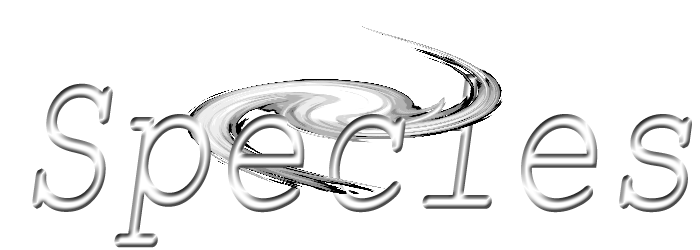

The Species of Ghelu are the most common humanoid inhabitants of this world. The word "species" is used lightly here, since the science of Ghelu isn't close to the one we are used to. These however are the groups of humanoids how they define themselves - it is more than likely that the borders especially between mixable species have been blurred millenia ago.
![]()
Disclaimer: The words and especially names are freely invented by me out of various reasons. I have written several words in bold font to distinguish them from the „normal“ world. Those bold font words descripe something inside the world I am creating here and have thus no direct connection to reality. I hope this clears any misunderstanding up front. Best example would be the word manic, which originates from the term Mane or Manes, describing a human in my world, not a real life term about a mental condition.
![]()
The Mankind – or Manes, adverb manic – splits up into the following species:
The Beregmanes are of smaller posture but greater body strengths. Their origin lies in the mountain areas. According to the Budmen, the Beregmanes were the first of the Manes, however the reason for that might be that the Budmen just met them first.
The Lendmanes are the widespread inhabitants of the lowlands, taller and more graceful, and basically the species that has defined Mankind. They have become the dominant species of the northern Harland. Most cannot distinguish the Lendmanes of the Beregmanes anymore, and both kinds have mixed a lot over the millenia of their existence. People who still distinguish between the two species are considered radicals.
The Morimanes are the manic inhabitants of the southern continent known as Gheland. They're exceptionally tall and prefer strong individuals. Also known as Skures, they're feared and respected as skilled seamen, traders but also pirates and warriors.
The Guermen are mostly portrait as wild and animalistic. They are the reason for the Egrodian term of Barbarii. They probably are of the same or a very similar origin as the Beregmanes. In their language they call themselves Mako.
The Xiaomin are the inhabitants of the western continent behind the Selgian sea (Selgmeer), called Peurden. They are of mostly bright complexion with dark hair.
The Daomin are the inhabitants of the western islands known as Godo. They're probably closely related to the Xiaomin but of a much darker complexion. The Skures met the Daomin first, and their name for them, Holmen, has spread to become the basic name for both the Xiaomin and Daomin.
![]()
Then there are the Manelike, who are of sometimes similar appearance, but probably have no relation to the Manes.
The Sulkel are huge beings living in the south, starting from the Kaitoger and Kaitland. They have dark, nearly black skin, long arms and their face is very different to the one of the normal Manes, much more rural. After enduring many centuries of being used as slaves especially around Regos, they're now much more respected and widespread within the manic areas of the world, but still prefer the strongly forested areas of their homeland. When respected, they're sometimes called Sulkelmanes, although they're probably unrelated to Manes and cannot mix with them. When insulted, they're called Suordo, which basically means dirty skinned or black skinned.
The Semier (or Semian people) are considered „half-manes“, sometimes even suspected to be the result of some insane experiment. Their skin is much brighter than the one of Manes, they're in average a little taller, live longer and especially age much slower. Their most significant visual identification however are the pointed ears that can be quite long. Also their hair can result in colors unthinkable for Manes, like blue, purple or green. They inhabit Tirsor and also have the majority in Kaliland. It is known that Semier and Manes can produce offspring, something that cannot be said about other Manelikes. Still the Semier are not very respected and often called Semis, indicating that they're only worth "half" a Mane. The Budmen (see below) mistrust the Semier as being the result of an Ansu experiment or somehow related to them.
The Orbo are of much more primitive origin. Not only are they smaller than the average Manes, they also show much less creativity. While most free Orbo live in small groups in areas that Manes normally don't frequent, the use of Orbo as cheap workers or slaves is still widespread since despite their smaller frame they're exceptionally strong and resistant. They call themselves Ure.
![]()
The Old Species are considered to be of a much older origin than the now-dominant Manes. They are part of many stories and myths, however are perceived very differently in the daily life.
The Budmen are of much smaller frame than all Manes and even grow at least a head shorter than the Beregmanes. However they come in very different forms, from surprising strength to graceful movement. Their life expectancy is significantly longer than the one of Manes, mostly a result of their resistance to about any commonly known disease. Budmen are considered the origin of craftsmanship and studies (and recently the gunpowder), and while most Manes believe that they have surpassed their abilities, they still hold the cooperation with the Budmen in the highest regards. The Budmen inhabit their own country of Goom, a mostly mountain-like area in the midst of Great Harland, whos borders are not only heavily fortified and guarded, but also closed to most Manes and all others. Outside of Goom they often run crafts and trades throughout the world and still have a watchful eye and indirect control over Moridem. Although widely respected, the Budmen are sometimes still insulted (especially between each others), called Dhuerge (Cripples), which resulted in the word Dwarf. Calling a Budmen like that however is a common reason for a fight.
The Ansu are nowadays nothing but a myth. Stories tell of a powerful species calling itself Gaoli or Gaoles that was friends with the dragons who once ruled the land. The vast majority of Manes doesn't believe that the Ansu actually exist, however most don't rule out that at one point they might have. The few sources portraying Ansu are talking about tall beings of grace and high skills, however physically not very strong. Their ears were pointed just like the Semiers and they also resembled the “half-manes” in many other ways. Rumour is that Ansu do not age at all, that they can change their appearance and that they commonly use the infamous power of Soito to change the world around them. About every story - especially of the Daomin and Xiaomin, who call them Anyu, portraits the Ansu as ghosts, demons, will-o'-wisps and other creatures from the dark depths of the world. In the very rich tradition of storytelling in the Ensani cultures they're called Div or Jinn, and mostly portrait the uncontrollable chaos. If they still exist, they must reside in the Tirudar, although some Semier proclaim that the Ansu are still very much existing and sharing the Tirsor with them. The Budmen consider the Ansu even worse than the Uorg.
The Uorg are of black complexion, much taller and stronger than the Manes and one of their oldest threats. While most Manes see them as monsters, Uorg actually have a deep social life which is based on a strong theocratic ruling. Their craft however is mostly practical, it is said they have developed a form of metal shaping that could give the Budmen a run for their money. Uorg are mostly perceived as violent looters who kill anybody who crosses their way. It is known that several large groups reside in the Gerbarre, however small packs of outcasts can be found any place where the Manes cannot stop them, making the wilderness an even more dangerous surrounding. The Uorg hate the Budmen with whom they seem to have clashed even before the existence of the Manes. They also mostly avoid any area inhabited by the Semier, which allows the conclusion that they might fear the Ansu.
![]()
The Dragonlike or Dragoni are a species that are of obviously different origin than any Manes, who (disrespectfully) call them Lizards or Coldbloods . In most parts they're on the brink of extinction since the Manes do not allow them to build social structures, the Budmen despise them deeply and the north of the more Dragoni tolerating Semier is already too cold.
The Selosi are considered the most intelligent of all Dragoni. They mostly inhabit warm swamp or moor areas and are leading a nomadic life. Many wanderers have been saved by Selosi when they strayed the path. If any tolerance is brought towards Dragoni, it is mostly shown to the Selosi. Some small groups could even build a somewhat permanent residence within the great manic swamplands which are too hostile for Manes anyway.
The Korosi are the exact opposite of their swamp inhabiting relatives. They roam the desert lands, especially the Dragon Desert in the south, which according to myth is inpassable - “If the desert doesn't kill you, the Korosi will.” These highly aggressive Dragoni are known to attack caravans, treks, small villages and anything else that they deem weak enough. The Sultanat of Zamin sees in the Korosi the greatest threat to its existence and supports a special order formed only for the purpose to battle them. The fact that the Korosi can retreat into the desert, sometimes ride very fast lizard creatures, withstand extreme amounts of heat and know about any water reservoir makes their species virtually immortal.
The Dheni is what's left of the former dominant Dragoni of the northern regions. They have been well and thoroughly defeated by the advancing Manes and survive mostly as their servants. Most Dheni wear the clothes of the Manes, and although being unable to speak their language, can be taught to read and write in it. Many Dheni are used to perform the tasks in the dreaded midday heat, however they cannot work as animal keepers since about all domestic animals react shyly up to aggressively towards any Dragoni. They also have to obey a strict birth control system which forbids them to mate and have offspring unless specifically allowed. The few free living Dheni are outlaws, and any Dheni caught not wearing a ring of possession can be killed at sight, which resulted in the term “lizardheaded”.
![]()
 |
 |
|||
 |
||||
![]()
